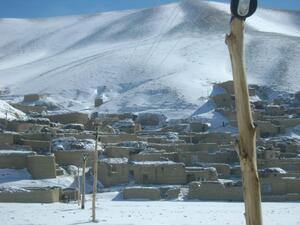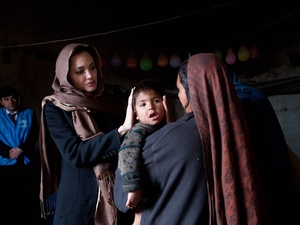New study highlights key reintegration challenges in Afghanistan
New study highlights key reintegration challenges in Afghanistan

A group of women learn how to keep bees in Nangarhar, one of the provinces featured in the report on reintegration of Afghan refugees.
KABUL, Afghanistan, December 5 (UNHCR) - A new study on the integration of returnees into the Afghan labour market since the end of hardline Taliban rule in 2001 has found a generally positive situation in the country, but highlights concerns about its future absorption capacity.
The European Commission-funded report, conducted by Kabul-based Altai Consulting and released in the Afghan capital on Monday, studied more than 600 rural and urban households - about 4,200 people - and 100 enterprises in the provinces of Kabul, Herat in the west and Nangarhar in the east. Some 40 percent of the estimated 4.7 million Afghan returnees live in these provinces, which have performed well compared to others in Afghanistan.
The survey, which was commissioned by UNHCR and the International Labour Organisation (ILO), included both men and women from Afghanistan's main ethnic groups and from different socio-economic backgrounds. A majority had returned from Iran and Pakistan, where on average they had spent 10 years.
"The study confirms what UNHCR has learned from its own monitoring of return and reintegration," said Jacques Mouchet, UNHCR's representative for Afghanistan, "It is a complex process with many different dynamics at work. While there have been difficulties for some, the majority of returnees have responded successfully and resiliently to the same challenges and opportunities faced by all Afghans."
The study found that the average monthly income per household was US$212, compared to mean monthly expenditure of US$200. However, income distribution indicated that 10 percent earned an average of US$920, but 90 percent earned an average of US$130. Of the latter figure, 35 percent had an income of less than US$100 per month.
Approximately 75 percent of households had only one source of income. Some 45 percent of those questioned described themselves as either employers or self employed. Only 11 percent said they were unemployed.
Many returnees said that during the years overseas they had gained in terms of knowledge, skills, education and new social and economic connections. But they also noted difficulties caused by loss of family, property, land and livelihood. A total 53 percent believed they were worse off economically than their neighbours, while adding that their social status, education and skill levels had improved and they could face the future with optimism.
"It is particularly encouraging that the study detected no substantial evidence of return to Iran and Pakistan by returnees. This corroborates what other research work has found. Ongoing population movements to neighbouring countries should not be confused with a refugee problem," Mouchet said.
The Afghan labour market and the economy as a whole remain highly informal. Support services for public or private sector employment are still very limited. Professional, family or ethnic networks emerged as the most important enablers for finding work, or information about jobs.
The surveyed households indicated that returnees were involved in a wide range of professions and employment though almost 60 percent were working in three sectors - construction, retail and wholesale, and manufacturing. Some 57 percent of returnees integrated into the labour market within three months, and almost 90 percent within six months.
In order to analyse profiles and expectations, more than two thirds of the 100 small-, medium- and large-sized enterprises surveyed were headed by returnees. Most enterprise owners were confident about the future with above two-thirds of those interviewed stating that they intended to expand their businesses in future.
The study found that integration into the labour market followed different patterns and was governed by two sets of factors - those pertaining to returnees' family and personal circumstances and assets before, during, and after exile, and those pertaining to the macro-economic environment, and the dynamics of individual sectors. Positive integration outcomes were recorded when returnees had improved their socio-economic situation and capabilities during exile and when they had access to well connected networks inside Afghanistan.
The survey raised concerns about the Afghan economy's future absorption capacity. With respect to future return and reintegration programmes, it found that new approaches would be needed if the majority of the estimated 3.5 million Afghans still in Iran and Pakistan are to return.
The survey recommended that to avoid social exclusion of those with limited assets, skills and networks, more emphasis will be needed on social integration, labour intensive employment programmes and market oriented vocational training. Meanwhile, the reintegration of better-educated Afghans and those with resources could be enhanced through business development services, access to credit and employment placement services, it said.
Piyasiri Wickramasekara, a senior ILO migration specialist, said the survey findings were very useful. "The study has not only broken new ground in our understanding of reintegration but it has provided valuable insights about the different segments of the labour market and how job opportunities are identified. This will be helpful in the design of future policies and initiatives for employment."
By Ewen Macleod in Kabul, Afghanistan








